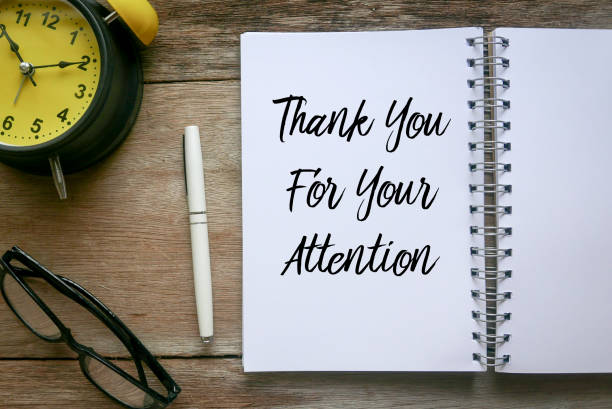Introduction
In the realm of presentations, the concluding slide holds significant weight. Often overshadowed by the main content, the Thank You for Your Attention slide is a critical component that can enhance the overall effectiveness of your presentation. This final slide is not just about wrapping up; it’s an opportunity to express gratitude, reinforce your key messages, and leave a lasting impression on your audience. In this extensive guide, we’ll explore the importance of this slide, how to craft it effectively, and best practices for its use in various contexts.
The Psychology Behind Gratitude
How Gratitude Impacts Audiences
Gratitude is a powerful psychological tool that influences how audiences perceive and remember your presentation. When you thank your audience, you acknowledge their time and attention, which can significantly improve their overall experience. This acknowledgment helps create a positive atmosphere and fosters a sense of mutual respect.
Think of gratitude as a bridge between you and your audience. Just as a warm handshake or a genuine compliment can build rapport in personal interaction, expressing thanks in a presentation helps establish a connection. It shows that you value their time and engagement, making them more receptive to your message.
Psychological Benefits of Saying Thank You
Expressing gratitude can also mitigate any negative feelings or discomfort your audience might have. It can lead to increased satisfaction and a more positive memory of your presentation. When people feel appreciated, they are more likely to remember your message favorably and be open to future interactions.
Gratitude can also have a calming effect, reducing any tension that might have built up during the presentation. By ending on a note of appreciation, you provide a sense of closure, which can enhance the overall impact of your presentation.
Elements of an Effective Thank You for Your Attention Slide
Design Principles
Visual Appeal
Designing an effective thank you slide involves more than just slapping a “Thank You” message on a screen. It requires thoughtful consideration of visual elements. Your slide should be visually appealing and align with the overall theme of your presentation.
Use high-quality images or graphics that complement your message. For example, if you’ve used specific colors or branding throughout your presentation, continue these themes on your thank you slide to maintain consistency. This visual coherence reinforces your brand or message and makes your presentation feel more polished.
Readability
Readability is crucial for ensuring your thank you slide effectively communicates your message. Use clear fonts and ensure the text size is large enough to be read from the back of the room. Avoid clutter by focusing on critical elements and keeping the design simple.
A good approach is to use a large, legible font for your main message and avoid overcrowding the slide with too much text. White space can be your friend here—allowing your message to breathe and making it easier for your audience to read and process.
Content Suggestions
What to Include
The content of your thank you slide should focus on expressing appreciation and reinforcing your main points. A simple Thank You for Your Attention message can be compelling, but you might also include a summary of your key takeaways or next steps if applicable.
If your presentation was interactive or involved audience participation, acknowledging that can add a personal touch. For instance, if you hold a Q&A session, thanking the audience for their questions and participation can help maintain a positive tone.
Common Mistakes to Avoid
Avoid common pitfalls such as overloading your slide with excessive information or including irrelevant details. The thank you slide should be concise and focused, emphasizing your gratitude without distracting from the main message.
Overloading the slide with less text or unrelated content can dilute the impact of your gratitude and make the slide less effective. Please keep it simple and to the point to ensure your appreciation comes across clearly.
Crafting a Memorable Thank You Slide
Visual Design Tips
Color Choices
Color choices can significantly impact the effectiveness of your thank you slide. Select colors that align with your presentation’s theme and visually contrast the text to ensure readability. For example, if your presentation has a professional tone, opt for muted or neutral colors with high-contrast text.
On the other hand, if your presentation is more casual or creative, you can use bolder colors to make the slide stand out. However, always ensure that the colors chosen do not overwhelm the message and maintain a balanced and professional appearance.
Font Styles and Sizes
The right font style and size are crucial for readability and overall design. Use fonts that are easy to read from a distance. Sans-serif fonts, like Arial or Helvetica, are often preferred for their clean and modern look.
Ensure the font size is large enough to be scanned by those sitting at the back of the room. A good rule of thumb is to use a font size of at least 24 points for the main message.
Effective Messaging
Wording and Tone
The wording on your thank you slide should be simple and sincere. Phrases like “Thank you for your time” or “I appreciate your attention” work well. The tone should match the overall mood of your presentation—whether it is formal, casual, or somewhere in between.
If appropriate, include a closing remark or a motivational quote related to your presentation’s theme. This can add a final touch of inspiration and reinforce the key message.
Personalization Techniques
Personalizing your thank you slide can make it more impactful. Address your audience directly and acknowledge any specific contributions or interactions. For example, if you’re presenting to a particular group or organization, mention their name or reference something relevant to them.
Including personal touches can make your appreciation feel more genuine and tailored to the audience. This approach can also enhance the overall connection between you and your audience.
Examples of Successful “Thank You” Slides
Corporate Presentations
Your thank you slide might include a call to action or next steps in corporate settings. For example, after a sales pitch, you might thank the audience and invite them to a follow-up meeting or provide contact information for further discussions.
Including a summary of key points or a brief overview of the proposal can also be effective. This reinforces the main message and provides a clear path forward for the audience.
Educational Settings
For academic presentations, your thank you slide can recap the lesson or summarize research findings. It can also include references for further reading or additional resources for interested audience members.
Acknowledging contributors or collaborators in your thank you slide can add a personal touch and demonstrate appreciation for their support.
Conferences and Seminars
At conferences and seminars, your thank you slide can include information about upcoming events or additional resources related to your presentation. This provides value to the audience and encourages ongoing engagement.
Including social media handles or professional contact information can also facilitate further interaction and networking opportunities.
Using Thank You for Your Attention in Different Contexts
Business Presentations
Sales Pitches
In sales presentations, the thank you slide is crucial to reinforce your pitch. It’s your final opportunity to leave a positive impression and encourage the audience to take action. Consider including a solid call to action or a recap of your key selling points.
Team Meetings
Your thank you slide might focus on acknowledging team efforts and summarizing the next steps for internal team meetings. This approach helps reinforce collaboration and ensure everyone is aligned with future actions.
Academic Presentations
Research Findings
When presenting research findings, your thank you slide can summarize critical results and highlight essential conclusions. This reinforces the significance of your research and provides a final overview for the audience.
Classroom Lectures
In a classroom setting, the thank you slide can recap the lesson and provide reminders for homework or additional resources. This helps reinforce learning and ensure students have clear takeaways from the presentation.
Public Speaking Events
Keynote Speeches
Your thank you slide for keynote speeches is an opportunity to make a final connection with the audience. Use it to express genuine appreciation and include a final motivational message or quote.
Workshops and Webinars
In workshops and webinars, your thank you slide can include information about upcoming events or provide additional resources related to the topic. This helps maintain engagement and offer continued value to the audience.
Common Mistakes to Avoid
Overloading with Information
A common mistake is overloading the thank you slide with excessive information. The slide should be concise and focused on expressing gratitude. Avoid including too much text or unrelated details that can detract from the main message.
Inconsistent Design
Ensure that your thank you slide matches the design of the rest of your presentation. Inconsistent design can be distracting and undermine the overall professionalism of your presentation.
Neglecting Audience Engagement
Maintaining engagement is important even on the final slide. Avoid a passive approach—use the thank you slide as an opportunity to reinforce your connection with the audience and leave a positive impression.
Tools and Software for Creating Effective Slides
Design Software
PowerPoint
PowerPoint is a widely used tool for creating presentation slides. Its extensive features and user-friendly interface make designing professional and visually appealing slides easy. You can customize templates, add graphics, and ensure your thank you slide aligns with the overall theme of your presentation.
Canva
Canva offers a range of customizable templates and design elements. It’s an excellent tool for visually stunning slides with minimal design experience. The Canvas drag-and-drop interface allows you to easily design a thank-you slide that stands out and complements your presentation.
Online Resources
SlideModel
SlideModel provides a variety of pre-designed slide templates that can be customized for your needs. This resource can help quickly create a polished and professional thank you slide.
Envato Elements
Envato Elements offers a vast library of presentation templates, graphics, and design assets. These resources can enhance your thank you slide and ensure it aligns with your presentation’s overall design.
Conclusion
The Thank You for Your Attention slide is more than a mere formality; it’s a vital part of your presentation that can significantly impact your message. Focusing on practical design, clear messaging, and appropriate context can help you create a memorable and impactful closing slide. Remember, the goal is to leave a positive and lasting impression, so use this final slide wisely to express your gratitude and enhance your audience’s overall experience.
FAQs
- 1. Why is a Thank You for Your Attention Slide important?
A Thank You for Your Attention slide is crucial because it shows appreciation for the audience’s time, reinforces your message, and leaves a positive final impression. It helps create a sense of closure and enhances the overall effectiveness of your presentation.
- 2. What are some practical design tips for this slide?
Practical design tips include using a clean layout, choosing contrasting colors for readability, and selecting legible fonts. Keep the slide simple, focusing on expressing gratitude without overwhelming the audience with information.
- 3. How can I personalize my thank you slide?
Personalize your thank you slide by addressing your audience directly, acknowledging their contributions or interactions, and incorporating elements related to their interests or the presentation topic. This adds a personal touch and makes your appreciation feel more genuine.
- 4. What common mistakes should I avoid?
Common mistakes include overcrowding the slide with too much text, inconsistent design with the rest of the presentation, and neglecting to engage the audience. Keep the slide focused on expressing thanks and maintain design consistency.
- 5. Which tools are best for creating this slide?
Tools like PowerPoint and Canva are excellent for creating effective thank-you slides. They offer a range of design features and templates to help you craft a professional and visually appealing slide.



